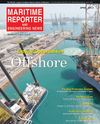
Page 71: of Maritime Reporter Magazine (April 2013)
Offshore Energy Edition
Read this page in Pdf, Flash or Html5 edition of April 2013 Maritime Reporter Magazine
www.marinelink.com 71Headhunter Completes AET Tankers Install Headhunter, Inc., completed the installa- tion of the company?s Tidalwave HMX sewage treatment plant on the Þ rst of two specially outÞ tted Aframax tankers owned by AET Tanker Holdings of Kua- la Lumpur, Malaysia. AET is a global leader in petroleum shipping with a ß eet of more than 80 vessels. The two Afra- max tankers have been chartered for 20 years to Marine Well Containment Com- pany of Houston, Texas. The Tidalwave HMX systems are USCG-certiÞ ed and BV-approved to IMO MEPC 159(55) standards. They can process up to 50,000 gal. (187 cu. m.) per day and use ß occulants, chemical oxidation, hydro-maceration and patented crossß ow separation tech- niques to destroy inß uent biomass. The six-stage process provides treatment of black and gray water and a sterile efß u-ent for disposal. www.headhunterinc.com ClassNK: AIP for Minimal Ballast Water VLCC Design ClassNK granted AIP (Approval in Prin- ciple) to the MIBS (Minimal Ballast Water Ship) VLCC design developed by Namura Shipbuilding Co., Ltd. in coop-eration with the Shipbuilding Research Centre of Japan. Although the IMO?s Ballast Water Man- agement Convention has yet to enter into force, installation of ballast water treatment systems are already presenting owners with both Þ nancial and technical challenges. Namura?s new MIBS VLCC design, addresses the challenges via the use of a revolutionary new hull form, which greatly reduces the amount of bal-last water necessary for safe operations. The MIBS design reduces the weight of ballast water required in normal ballast conditions by around 65%, paving the way for the use of smaller ballast wa-ter treatment systems and reducing fuel consumption.This new MIBS design builds on a pre-vious Non-Ballast Water Ship (NOBS) design project promoted by the Japan Ship Technology Research Association as part of a Japanese national project under the initiative of Ministry of Land, Infrastructure and Transport and sup- ported by Japan Railway Construction, Transport and Technology Agency and The Nippon Foundation, and further de-veloped by Mitsubishi Heavy Industries, IHI Marine United (now Japan Marine United), Shipbuilding Research Center of Japan and ClassNK. While the NOBS project succeeded in creating tanker de-signs which could operate without the need for ballast water, the extremely wide hull shape limited its commercial applications. The MIBS design however, incorporates features from the NOBS design with a ß atter bottom and standard breadth hull. This allows for a dramatic reduction in the amount of ballast water needed, while maintaining the dimen-sions of a standard VLCC. www.classnk.or.jp MR #4 (66-74).indd 71MR #4 (66-74).indd 714/2/2013 5:06:05 PM4/2/2013 5:06:05 PM

 70
70

 72
72
